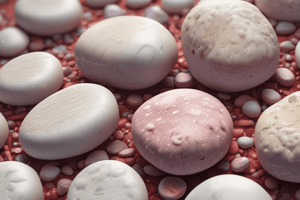Podcast
Questions and Answers
What was the condition that both brothers were suffering from?
What was the condition that both brothers were suffering from?
- Urinary tract infection
- Renal failure
- Kidney disease
- Urinary stones due to calcium oxalate (correct)
What was the treatment advised to the brothers?
What was the treatment advised to the brothers?
- Alkaline therapy and decrease in phosphate intake
- Increased fluid intake and a low oxalate diet (correct)
- Potassium citrate therapy and decrease in calcium intake
- Medication and surgery
What was the difference in the outcome between the two brothers?
What was the difference in the outcome between the two brothers?
- The younger brother had a family history of urolithiasis
- The younger brother had a more severe case
- The younger brother followed the advised treatment and remained symptom-free (correct)
- The younger brother developed more severe symptoms
What was the result of the 24-hour urine biochemical analysis?
What was the result of the 24-hour urine biochemical analysis?
What was the result of the IVP (Intravenous Pyelogram) test for the elder brother?
What was the result of the IVP (Intravenous Pyelogram) test for the elder brother?
What was the notable finding in the serum biochemical analysis?
What was the notable finding in the serum biochemical analysis?
What was the radiological finding in the right kidney of the elder brother?
What was the radiological finding in the right kidney of the elder brother?
What was the patient's symptom in Case study 2?
What was the patient's symptom in Case study 2?
What was the diagnosis in Case study 2?
What was the diagnosis in Case study 2?
What is the sensitivity of KUB in detecting ureteric or calcified calculi?
What is the sensitivity of KUB in detecting ureteric or calcified calculi?
What was the treatment for the ureteral stone in Case study 3?
What was the treatment for the ureteral stone in Case study 3?
What was the abnormality found in the dog's urine sample?
What was the abnormality found in the dog's urine sample?
What was the initial clinical presentation of the dog?
What was the initial clinical presentation of the dog?
What was the specific gravity of the urine in Case Study 5?
What was the specific gravity of the urine in Case Study 5?
What is the diagnostic role of ultrasound in nephrolithiasis?
What is the diagnostic role of ultrasound in nephrolithiasis?
What was the pH of the urine in Case Study 2?
What was the pH of the urine in Case Study 2?
What is the limitation of abdominal X-ray (KUB) in nephrolithiasis?
What is the limitation of abdominal X-ray (KUB) in nephrolithiasis?
What was the diagnosis made for Patient XY?
What was the diagnosis made for Patient XY?
What was the effect of fenofibrate on stone formation in Case study 3?
What was the effect of fenofibrate on stone formation in Case study 3?
What was the treatment approach for Patient AH?
What was the treatment approach for Patient AH?
What was the outcome of the treatment approach for Patient AH?
What was the outcome of the treatment approach for Patient AH?
What was the finding on abdominal ultrasonography for Case Study 5?
What was the finding on abdominal ultrasonography for Case Study 5?
What was the medication used to treat Patient AH?
What was the medication used to treat Patient AH?
What was the UA/Cr ratio of Patient AH?
What was the UA/Cr ratio of Patient AH?
What was the outcome of the 24-hour urine analysis for Patient AH?
What was the outcome of the 24-hour urine analysis for Patient AH?
What was the result of the USS at six months for Patient AH?
What was the result of the USS at six months for Patient AH?
Flashcards are hidden until you start studying




